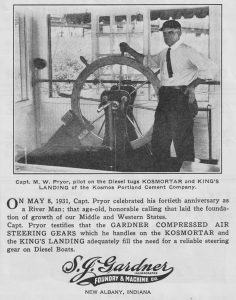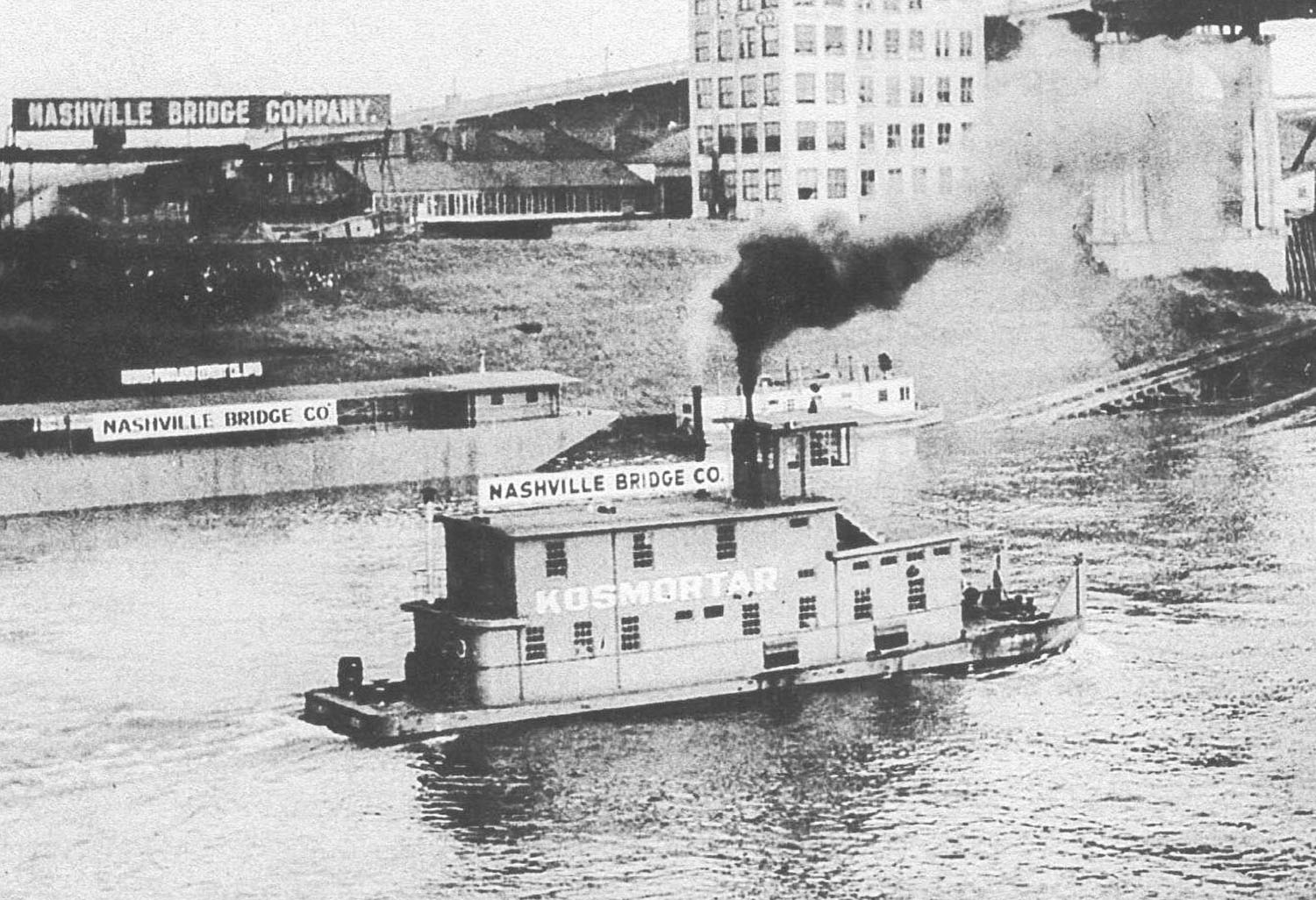Early in the 20th century, a Philadelphia industrialist named Samuel Horner Jr. built a cement mill a short distance from the banks of the Ohio River and a few miles above the mouth of the Salt River. The firm was formed as the Kosmos Portland Cement Company. Horner also opened a quarry some 35 miles downstream to feed limestone to the cement mill. In conjunction with these operations, two company towns were established. The one near the mill became Kosmosdale, Ky., while the one near the quarry at Richardsons Landing was called Oolite, due to the oolite limestone quarried there.
David L. Baker wrote a definitive history of the company in 2010 that goes into great detail about the concern, and the river operations in particular. The quarry opened in 1904, and the stone was delivered to Kosmosdale by boats of the Louisville & Evansville Packet Company. In 1905, this company failed, and the rock was then towed by Capt. Steve Green, formerly affiliated with the packet company, who had purchased a small towboat with which to do the work. He would continue to do this with various boats under his ownership for the next several years.
The Kosmos company was heavily involved with providing cement to contractors building the original series of Ohio River locks and dams prior to World War I, primarily Lock 41 at Louisville, Lock 43 just below West Point, Ky., and Lock 48 near Henderson, Ky. Kosmos naturally began expanding its river operations, and in 1922 it had a new prop-driven diesel boat built for the company’s use by the Nashville Bridge Company, Nashville, Tenn. Named Kosmos, the small boat was rated at 180 hp. This boat was the beginning of the Kosmos Towing Company, as well as the tradition of naming the company boats with names beginning with the letter K, and a long-running relationship with Nashville Bridge Company.
In 1925, Nashville Bridge delivered a slightly larger boat to Kosmos. The twin-screw boat had a steel hull 73.3 feet by 19.1 feet and was powered by a pair of 120 hp. Worthington diesels. It was named Kosmortar after the company brand of masonry cement. Photos of it on trials at Nashville show a rather boxy cabin with no upper guards. The cabin construction was primarily of wood. The Kosmortar regularly ran from the company landing at Kosmosdale to Cincinnati and Evansville, Ind. Often the boat would tramp other barges along with the Kosmos barges for added revenue. In 1926, a nearly identical boat named Kings Landing was built at Nashville and joined the Kosmortar in this trade.
Both of the twins performed admirable flood assistance work during the disastrous 1937 flood, particularly in the Evansville, Ind., area. As larger boats were acquired by Kosmos, the two were relegated to towing rock from the quarry to Kosmosdale, or to shifting operations. In 1961, the Kosmortar was rebuilt and after this the hull dimensions were 77 feet by 23 feet. It was repowered in 1953 with a pair of Cat D-386 diesels totaling 640 hp.
The Horner family sold their interest in the company in 1957, and 10 years later Kosmos sold all its towboats, except for the Kings Landing, which was retained to shift at Kosmosdale. The Kosmortar was sold to McBride Towing Company, Harrods Creek, Ky.

The Kosmortar was a fixture around the refinery and docks at West Louisville for many years. In 1974, it was sold to Five M Transportation Corporation, Louisville, which was named for five McBride siblings. Following an altercation with the L&I Railroad drawbridge at the head of the Louisville & Portland canal, it was rebuilt at Marine Builders, Clarksville, Ind. This rebuilding included a new pilothouse, yet the boat overall retained its original appearance. In 1975 it was renamed Michelle McBride. In 1983, it was again repowered with Cat 3408 engines, giving it some 820 hp.
The Kings Landing was last listed in the 1993 edition of the Inland River Record, shown in the “In Limbo” section as having been sold to an unknown owner.
On the evening of February 11, 1995, following 70 years of service in the Louisville area, the Michelle McBride burned at West Louisville. The Valvoline, of Ashland Oil Inc., Capt. Marty Leake, was building tow nearby and was able to rescue the crew from the burning boat. The fire was so intense that it burned the towknee pennants on the Valvoline as it nosed in to pick up the McBride crew. The hull of the McBride sat in the headline string of the Five M Transportation main fleet at West Louisville for some time and was eventually scrapped.




